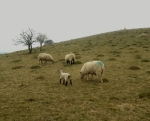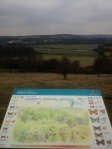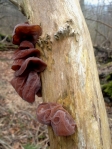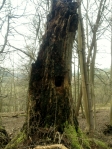Last week I retraced the route of a competition run I took part in last year. Back in October I battled my way through the 9.7 mile Ridgeway Run and one thing that spurred me on was the unexpectedly glorious scenery midway through the route. I now know that this part of the run went through the Ashridge Estate in the Chilterns Area of Outstanding Beauty and nature reserve called Aldbury Nowers.
Aldbury Nowers is situated on the Chiltern escarpment adjoining the Ridgeway National Trail with amazing views across the Tring Gap and Vale of Aylesbury. It was one of the original 284 reserves identified by Charles Rothschild, the founder of the Wildlife Trust movement, as needing protection back in 1912 and it is regarded as one of the finest butterfly habitats in Hertfordshire. Herts & Middlesex Wildlife Trust manage the reserve “to prevent the important areas of short turf from being overgrown with rank grasses, scrub and encroaching woodland. This is achieved through selective clearance and careful grazing by older breeds of sheep such as Shetlands” (source: Herts Wildlife Trust).
The Ashridge Estate covers 5000 acres and contains ancient hill forts, earthworks and track ways. It’s home to abundant wildlife including fallow deer, badgers, muntjac, foxes, bats, songbirds, birds of prey and rare butterflies. Wild flowers flourish on the sheep grazed chalk downland and the Ashridge estate has 2000 acres of mature woodland including magnificent Beeches and Oaks. In fact somewhere in Ashridge Woods lives the Whomping Willow of Harry Potter fame – Ashridge was used as a film location for Harry Potter and the Goblet of Fire.
The woodlands are noticably rich in standing and fallen dead wood, much more so than any other woodland I’ve visited and it’s this abundant dead wood which supports a huge variety of fungi and insect life creating a woodland alive with birdsong in Spring.
During my meander I chatted with Steve, one of the estate workers. I found him working on a newly cleared sunny slope. The area had previously been planted with Corsican Pine in the 70’s as a revenue source but 40 years on the trees were spindly, stressed, densely packed and blocking light. The Pines had never been productive and had also created a sterile habitat inhospitable to wildlife. Steve said, even the birds weren’t using the Pine canopy for nesting sites, so the trees were being removed. Historically the site had been grazed and was open chalk grassland with orchids. It is now being returned to it’s original state. Now that the trees have been cleared the top soil is being removed and Steve anticipates that the dormant orchid seeds will spring into action within one to two years and transform the sunny slope. With a couple of viewing ‘holes’ cut through to the vista below and some well placed benches it will no doubt be a favourite spot for visitors in the future.
The Ashridge Estate is owned by the National Trust and is often looking for volunteers to help with plant surveys, sensitive scrub clearance and even help in the cafe and shop. If you’d like to get involved and make a difference why not give them a call on 01442 841800. Or how about a working holiday where you stay in accommodation on a National Trust site whilst volunteering over a long weekend or week long break. I’ll definitely be returning to see the wild flower meadows and butterflies in summer.





Good post, great blog!
Thanks for your comment, that’s very kind. If you’re ever in the area it’s worth a visit.
Thanks you’re very kind.
Just took a look at yours. I look forward to more.